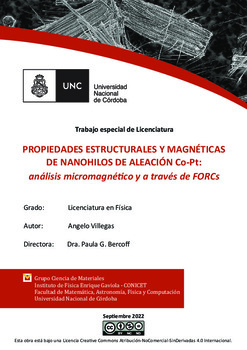| dc.contributor.advisor | Bercoff, Paula Gabriela | |
| dc.contributor.author | Villegas, Angelo | |
| dc.date.accessioned | 2022-11-03T12:22:25Z | |
| dc.date.available | 2022-11-03T12:22:25Z | |
| dc.date.issued | 2022-09 | |
| dc.identifier.uri | http://hdl.handle.net/11086/29319 | |
| dc.description | Tesis (Lic. en Física)--Universidad Nacional de Córdoba, Facultad de Matemática, Astronomía, Física y Computación, 2022. | es |
| dc.description.abstract | En este trabajo estudiamos arreglos de nanohilos (NHs) bimetálicos de Co-Pt, enfocándonos en sus propiedades magnéticas, mediante análisis de micromagnetismo y del modelo de Preisach a través de las distribuciones FORC (First Order Reversal Curves). Centramos el estudio en dos muestras ricas en Co (Co95Pt5), preparadas usando la técnica de electrodeposición en dos tipos de membranas de alúmina nanoporosa fabricadas, cada una, por dos métodos diferentes: anodizado doble (MAN-AD) y fuerte (MAN-HA). Mediante microscopía SEM estudiamos la morfología y por difracción de rayos X la microestructura de las muestras, mientras que determinamos las propiedades magnéticas a partir de los ciclos mayores de histéresis y las FORCs, conseguidas por medio de magnetometría de muestra vibrante a temperatura ambiente. Los NHs crecidos en la MAN-AD se someteron a un tratamiento térmico luego de realizar las caracterizaciones pertinentes. Observamos que las muestras estudiadas cristalizan en la fase hcp con textura cristalográfica fuera del eje de los NHs, con tendencia a ubicar el eje c en el plano del arreglo. El análisis magnético de los NHs crecidos en la MAN-AD muestra que el tratamiento térmico tuvo marcadas implicancias a la hora de orientar el eje de fácil magnetización de los NHs. Además, el estudio de la coercitividad con respecto al ángulo de aplicación del campo indica que, si bien los mecanismos de reversión de la magnetización son los mismos, se manifiestan de distinta manera en el arreglo según se haya realizado o no el tratamiento térmico. Más aún, las distribuciones FORC presentan un perfil de forma wishbone, revelando la presencia aparente de dos fases magnéticas no detectadas en las curvas M(H). Por otro lado, en el arreglo de NHs crecidos en la MAN-HA, resultan evidentes las interacciones dipolares desmagnetizantes. Por último, estudiamos las magnitudes de las diferentes anisotropías que gobiernan las muestras, encontrando que la anisotropía magnetocristalina compite con la de forma en todos los casos, pero la anisotropía de interacción dipolar resulta ser la más elevada. | es |
| dc.description.abstract | In this work we study bimetallic Co-Pt nanowire (NW) arrays, focusing on their magnetic properties, by means of micromagnetism and Preisach model analysis through FORC (First Order Reversal Curves) distributions. We center the study on two Co (Co95Pt5)-rich samples using the electrodeposition technique on two types of nanoporous alumina templates, each one fabricated by two different methods: double anodization (MAN-AD) and hard anodization (MAN-HA). By SEM microscopy we studied the morphology and by X-ray diffraction the microstructure of the samples, while we determined the magnetic properties from the major hysteresis loops and the FORCs, obtained by vibrating sample magnetometry at room temperature. The NHs grown in the MAN-AD was annealed at 500ºC after performing the relevant characterizations. We observe that the studied samples crystallize in the hcp structure with a crystallographic texture out of the NWs axis, with a tendency to locate the c axis lying on the array's plane. The magnetic analysis of the array grown in MAN-AD before and after thermal treatment showed that the annealing had remarkable implications regarding the orientation the NWs easy axis. Besides, the study of coercivity as a function of the applied field direction indicates that the magnetization reversal mechanism is the same in both samples but operates differently. The FORC distributions of these samples present a wishbone-shaped profile, revealing the apparent presence of two magnetic contributions, which are undetected in the hysteresis loops. On the other hand, in the array grown in the MAN-HA, demagnetizing dipolar interactions are evident. Finally, the magnitudes of the different anisotropies that govern the samples were compared. It was found that the magnetocrystalline anisotropy competes with the shape anisotropy in all cases, but the dipolar interaction anisotropy is the largest. | en |
| dc.language.iso | spa | es |
| dc.rights | Attribution-NonCommercial-NoDerivatives 4.0 Internacional | * |
| dc.rights.uri | http://creativecommons.org/licenses/by-nc-nd/4.0/ | * |
| dc.subject | Física de materiales | es |
| dc.subject | Magnetismo | es |
| dc.subject | Nanoestructuras | es |
| dc.subject | Micromagnetismo | es |
| dc.subject | Nanohilos de Co-Pt | es |
| dc.subject | Electrodeposición | es |
| dc.subject | Curvas de inversión de primer orden | es |
| dc.subject | Anisotropías magnéticas | es |
| dc.subject | Estructura cristalina | es |
| dc.subject | FORCs | en |
| dc.subject | Materials physics | en |
| dc.subject | Co-Pt Nanowires | en |
| dc.subject | Electrodeposition | en |
| dc.subject | Magnetism | en |
| dc.subject | Magnetic anisotropies | en |
| dc.subject | Crystalline structures | en |
| dc.subject | First order reversal curves | en |
| dc.title | Propiedades estructurales y magnéticas de nanohilos de aleación Co-Pt : análisis micromagnético y a través de FORCs | es |
| dc.type | bachelorThesis | es |
| dc.description.fil | Fil: Villegas, Angelo. Universidad Nacional de Córdoba. Facultad de Matemática, Astronomía, Física y Computación; Argentina. | es |





